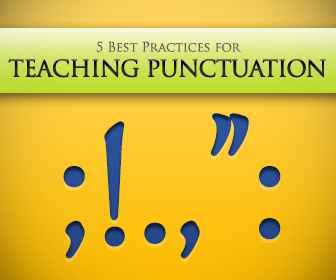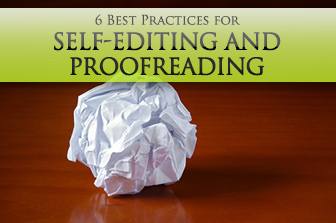How to Teach Punctuation Skills: 5 Best Practices


I’m always a little shocked whenever I see something of mine in print (“Really? How could I have missed that?”) Of course, it is much easier to proofread someone else’s work than one’s own, which is why one proofreading technique is to let a reliable friend look the work over before submitting it. This is not always possible, however. There are, fortunately, a number of methods students can use for proofreading their own work.

To adequately proofread work, especially one’s own, intense focus on it is usually required, meaning distractions like music, conversation, TV, internet, etc. need to be minimized or eliminated. It’s hard, in our plugged-in, electronic world to avoid these distractions, but looking for editing and proofreading errors in one’s own work, which is so familiar as to be almost invisible, requires too much attention, attention that can’t be shared with the lyrics of your favorite music.
Editing and proofreading, especially of a first draft, can seem overwhelming. Where do you even start? With the ambiguous vocabulary? The problematic sentence construction? The nonstandard punctuation? It’s easy to just give up and see if you can get your best friend to have a look rather than develop your own self-editing skills. One answer to this dilemma is to make multiple passes of the work—one first for content, focusing on the overall message and how if the way it’s said makes sense, then a second pass focusing on the grammar and sentence structure, and then finally on to usage like word choice, punctuation, and spelling. There are two benefits to this method: not only is it less overwhelming a task to focus on one area at a time, but also one piece of writing gets multiple and increasingly detailed reviews.
Is it “uninterested” or “disinterested” in this context? Do I need a colon or semi-colon in this place? Do I mean “affect” or “effect” here? These are actually complex grammar/usage questions that are not easily Googled for an answer because of their very complexity. Rather standard reference materials, such as a style book, a thesaurus, and a dictionary is needed. One barrier is that many students today, because of online availability, don’t own such reference books, which really should be a part of every student’s library. In addition, if these materials are owned by the student, they are often inaccessible. It is physically much more difficult to look something up in a cumbersome dictionary than look online. I’m unlikely to go look for the thesaurus downstairs or try to pull it down from a stack of books on my desk, risking sending everything cascading, while I’m working on an article. It’s much easier to try to Google my question, which again may very well not yield the needed results. So to use valuable reference books, they must be easily accessible. Keep them on the floor next to your computer, if necessary, when you are writing if the alternative is a high shelf. A caveat to this is that use of online materials will work if they are bookmarked on students’ computers (rather than Googled), such as the Webster’s dictionary, which is similar online to the print version.
This seems counterintuitive, as of course language is more about meaning and content than about using the right punctuation or usage. However, this principle should be ignored when editing, where the editing issues actually do take precedence over meaning: we are at the stage in our writing, now having edited for content, to focus on issues of grammar, usage, and punctuation. Also, reading a piece for content distracts the reader from minor problems like dropped apostrophes and spelling because naturally the reader’s attention has shifted back to the overall meaning of the message rather than on editing issues.
Reading aloud again gets the reader to focus on his or her own work: the words, their sound, and how the sentences work together. In addition, he will learn to recognize some of his bigger mistakes, such as the dropped plural or past tense ending. Even problems with punctuation may benefit from this method as that in reading aloud the student can hear that run-on sentence that needs to be split into two, for example, or at least into two clauses connected with a coordinating conjunction and comma, or that sentence fragment that needs to be connected to the following sentence with a comma.
Reading from back to front, sentence by sentence, is another way to get the reader really focused on the grammar and usage errors rather than focusing on the larger meaning. Starting with the last sentence of the piece, read it silently or out loud and consider its grammar, punctuation, and spelling. Then proceed to the next to last sentence, and so on, editing sentence by sentence, until the beginning of the piece has been reached. This method ensures that the reader is not focusing on content but on editing.
It’s rather like trying to really “see” ourselves in the mirror as others see us—not really ever possible due to a number of real and metaphorical differences in perspective. However by focusing, and focusing on the grammar and usage specifically, rather than the content and meaning, the writer can begin to self-edit and not rely so much on well-meaning and tired friends.